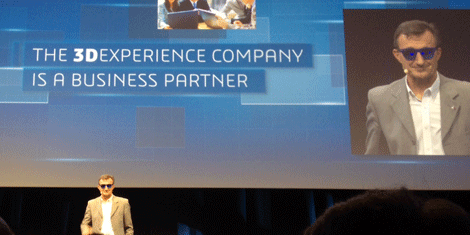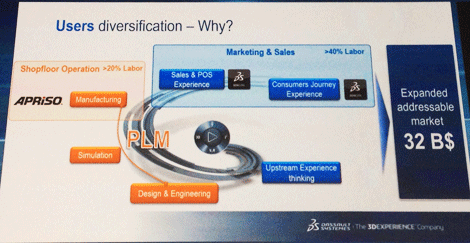
A future so bright it needs sunglasses? CEO Bernard Charles was in high spirits as he addressed the Dassault Systèmes global partner conference
Dassault Systèmes (DS) has made bold statements in its time, but now it’s openly gunning for a bigger chunk of the software market, its CEO Bernard Charles, trumpeting: “We have taken a very different strategy… Which is going to change the world of design”.
In the midst of its annual reseller and developer event, the clearest insight to how DS’ latest strategy is shaping up was given: ‘the Cloud is your future, you need to change your mindset, you need to invest in it like we are’.
DS boasted that its investment into developing all its software to work on the cloud has ran to over a billion dollars – a surprising amount considering it has hardly been the software company shouting the loudest about moving its products on to it.
Assisted by this shift, DS is looking to encompass new industry sectors – worth a potential $32b.
There are a range of options on the cloud from DS, although ‘private clouds’ will be available to customers by the end of this year, being hosted from six different sites spotted across the globe, with the expectancy for future growth.
This is seen as the answer to those wary of having their data on an ‘open’ cloud.
The wholesale move onto the cloud is proposed by DS as cost effective for all business sizes, allowing smaller companies to take up its products perceived as for the big boys, such as PLM system Enovia.
With this in mind, its entire product range will soon be available directly from the cloud.

A $32b market just waiting to be conquered?
DS perceives its market growth here, pinning to it an expansion into faster growing new industries, with life sciences, AEC, and marketing agencies making up the bulk of its predicted potential $32b.
However, these giant figures should probably have a more conservative edge.
While Frank Gehry was popping up in a video about how his architectural practice uses Catia, and DS’ Façade Design for Fabrication software is soon to be released, the AEC market is a stubborn one to break into.
Dominated by a couple of well established software heavyweights, Autodesk and Bentley Systems, there’s still stiff competition in the more specialist industry fields, such as the much loved Rhino.
The purchase of 3DXcite (formerly visualisation tool RTT) was announced as the solution for transitioning 3D data into deliverables for sales, marketing and point of sale use.
According to DS, budgets for marketing products – or ‘selling the user experience’ – are much greater than those given to the initial design and manufacturing outlay and it hopes its range of applicable software can tap into this.
However, using CAD data to produce visualisations for products has already been the case for about a decade now.
If DS customers haven’t already sourced a rendering software package then chances are they don’t feel they need one, otherwise they are already using RTT, or prefer an alternative.
One thing in its favour is that everything from initial concept design, to sales monitoring, to ‘which shelf in the supermarket should we place it on?’ is all in one ‘seamless’ environment.
DS now has a truly end-to-end software package that, should you require an entire solution in a neat bundle, will probably serve all needed purposes for the modern design lifecycle.
//www.youtube.com/embed/FFJweo1sACQ
Similarly, the cloud opens up a world of processing power, accessibility and collaborative working – but it all stops at persuading companies that they need to change to this system.
There’s a slight issue with this, as we found out firsthand on the big stage: the people that truly change perceptions are the resellers that users turn to when they’ve a problem, or need some training, or any of the myriad of things a giant software company hasn’t the time to sort out.
By DS moving the product they sell to a cloud-based system the resellers are going to have to restructure how they do business.
Big 5-year contracts, where CAD seat-purchases form the big chunk of income, followed by lesser amounts for support and services will become a thing of the past.
On the cloud resellers will be left with smaller ‘annual upgrade’ purchases, and slightly higher revenues from the amount of support they offer.
As DS admitted, it is going to need its resellers to hold the customers’ hands during the transition to the cloud, for which there will be obvious rewards, but once that’s over it’s anyone’s guess of the revenue resellers will be able to bring in.
So with this in mind, how many resellers will be flocking to move its customers over on to the cloud?
Even as they do move, as Peter Teague, CEO of UK SolidWorks reseller NT CADCAM, rightly explained, they will have to balance the changeover. If they were to move everyone over to the cloud in one big rush, their income would completely fall through the floor.
It’s not a problem unique to DS in any sense; every design software manufacturer is having the same issue right now, while in industries such as video games the change is already well underway with much uncertainty and grumbling.
While the world is happy having its entire Celine Dion music collection on its iTunes cloud, having something slightly more valuable ‘up there’ is more of a sticking point. Similarly, the ‘live’ services industry that surrounds it will need to consist of more than a week-long residency in a Las Vegas casino.
DS’ vision is, quite rightly, becoming reality – a world in which companies of all sizes can leverage the powers of collaborative cloud working, sharing data between all departments fluidly through a single software partner solution that offers top-end products.
Yet the shift to this, as exciting as it looks, seems likely to be a laboured process, one which DS is going to have to get around before the world of design is shouting as loudly as it is.






